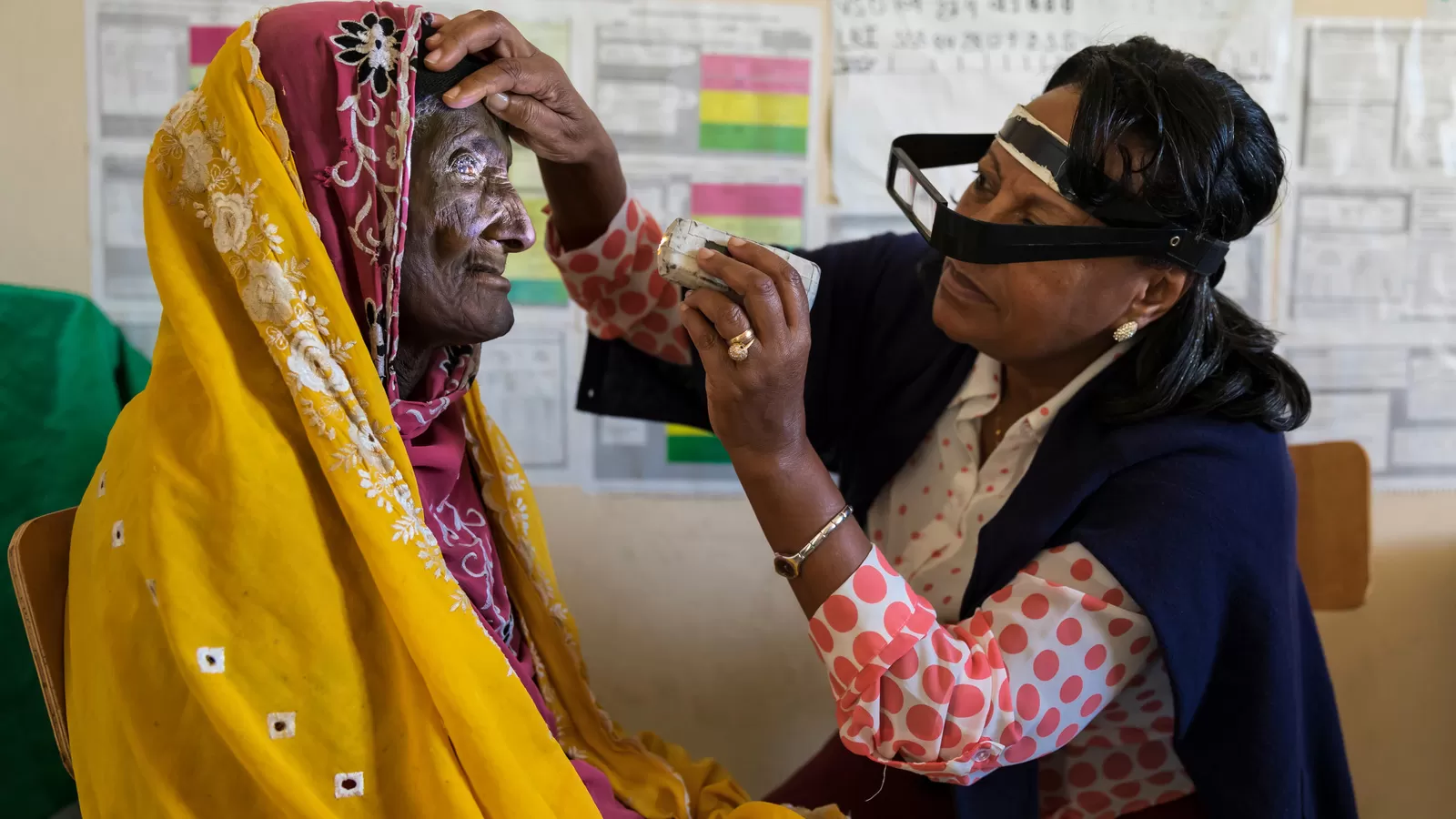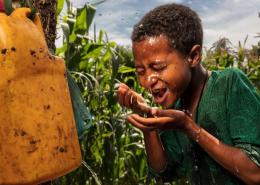A Billion Doses Delivered: 3 Lessons from the Fight Against Trachoma

Credit: Brent Stirton/Getty Images for ITI
Imagine an infection that causes your eyelids to turn inward, so that your lashes—intended to protect your eyes—scrape against the sensitive outer surface of your eye every time you blink. The pain is excruciating and constant. Your eyes water. Your lashes scratch and scar your cornea, the clear tissue covering your eye. Your vision becomes increasingly hazy.
That’s reality for nearly two million people. According to the World Health Organization (WHO), 1.9 million people around the world suffer visual impairment due to trachoma, a bacterial disease that has long been a leading cause of blindness.1 Though trachoma was eliminated in the United States by the 1950s, it continues to cause blindness, disability, and suffering throughout the world.2 Trachoma is the number one infectious cause of blindness.1
A common antibiotic, however, can help to prevent and treat the infection that causes trachoma and, when administered as part of a comprehensive public health strategy, can virtually eliminate the disease. Since 1998, Pfizer has donated more than one billion doses of an antibiotic medication to international efforts to abolish trachoma.
The global prevalence of trachoma has decreased by an estimated 92%.3 Because of the efforts of thousands of individuals, an African grandmother in her fifties can see the faces of her grandchildren, attend church, and cook for her family, says Paul Emerson, PhD, Director of the International Trachoma Initiative (ITI).
“We talk about these mind-bogglingly large numbers—one billion antibiotic doses, over 300 million people treated—but behind those large numbers are individuals whose lives have been genuinely improved,” Emerson says.
“I’ll never forget the old man I met in Ethiopia in a village about five hours off the main road. Trachoma was common in his village. He'd brought his family to get antibiotics to help prevent and treat trachoma, and they had been waiting all day to receive the treatment. I asked him, ‘Why do you come out and take this medicine?’"
"He grabbed me by the wrist," Emerson says, "and through an interpreter said, ‘You may think these are just some tablets for people at the end of the road. But to me, these tablets show that someone is thinking about and cares about me and my family.’”
Cooperation Can Solve Seemingly Intractable Problems
In 1996, the WHO launched the WHO Alliance for the Global Elimination of Trachoma by 2020 (GET 2020).4 Their goal was ambitious and audacious.
Although improved sanitation and easier access to medical care had already eliminated trachoma in much of the world, the disease remained a persistent public health problem in poor and rural areas of Africa, Central and South America, Asia, Australia, and the Middle East.1 Children and women were particularly affected. In some regions, as many as 60% to 90% of preschool-aged children were infected, and their caregivers—largely women—suffered repeated bouts of infection due to frequent exposure.1 Many adults experienced the onset of visual impairment between the ages of 30 and 40 years.1
But the scientific community knew how to combat trachoma, one of 20 known neglected tropical diseases (NTDs).5 WHO endorsed the "SAFE strategy," a set of interventions proven to disrupt transmission, treat infection, and prevent blindness:6
Surgery to correct late-stage disease
Antibiotics to help prevent and treat infection
Facial cleanliness to decease infection
Environmental improvement to reduce the risk of transmission and infection
In 1998, Pfizer cofounded the International Trachoma Initiative in cooperation with the Edna McConnell Clark Foundation. With an initial pledge to donate, over the first five years, 10 million doses of a treatment to the effort to eliminate trachoma,7,8 in 2003, Pfizer increased that donation to 35 million doses over the following five years.7
The results from the contributions and donations of dozens of governmental, nongovernmental, and public health organizations over these years have been extraordinary. The global prevalence of trachoma has decreased by 92%, and 15 countries (Cambodia, China, Gambia, Islamic Republic of Iran, Lao People’s Democratic Republic, Ghana, Malawi, Mexico, Morocco, Myanmar, Nepal, Omen, Saudi Arabia, and Vanuatu) have been validated by WHO as having eliminated trachoma as a public health problem.1
The gains made thus far have convinced public health experts that global elimination by 2030 (the revised target date) is within reach.9 And the success of international efforts to eliminate trachoma suggests that eliminating other persistent public health issues is also possible.
“We may be able to use the lessons we’ve learned, working across different sectors and over a long period of time, to address other challenges,” says Niesha Foster, Pfizer’s Vice President of Product Access, Global Health & Social Impact.
Three lessons from the fight against trachoma may help global leaders and concerned citizens tackle other neglected tropical diseases and socioeconomic drivers of disease:
Lesson #1: Commit to a Resolution
It takes long-term fortitude to resolve long-standing problems. Though Pfizer initially pledged ten million doses of medication to the effort to eliminate trachoma, that number has since reached a billion doses (and counting).
“Our leadership saw this as a global health challenge that fully aligns with our mission to change patient’s lives and wanted to be part of solving it,” says Foster, noting that the company’s commitment to trachoma elimination has persisted despite leadership changes.
Such dedication can convince others to commit their time and resources. In part because of Pfizer's longstanding antibiotic donation, other organizations have felt comfortable joining the effort. “With that critical pillar in place, NGOs and governments had something they could plan around and budget for,” says Julie Jenson, Pfizer’s International Director of Product Access. “A shared commitment really helps people focus and actually helps get more resources on board.”
A long-term strategy for resolution must also include investments in human capacity. “We’ve helped ensure the sustainability of this effort by supporting young researchers and nurturing the careers of field distribution people,” says Charles Knirsch, MD, MPH, Vice President of Clinical Research and Development at Pfizer. “Some of these folks end up getting advanced degrees and becoming the next leaders in their countries’ ministries of health.”
These investments ensure that work will continue until the problem is resolved.
Lesson #2: Cultivate Cross-sector Partnerships
No one entity can solve a global problem. Local conditions vary, and on-the-ground experts are needed to identify and address unique concerns. The effort to eliminate trachoma has involved such organizations as USAID, the Carter Center, the Bill & Melinda Gates Foundation, Lion’s Club International, and more, as well as thousands of community health workers. Each organization and individual brings a unique and valuable skillset to the work.
“It’s important to recognize what your core competencies and strengths are, and then bring in others who have complementary strengths and skills,” Knirsch says.
The trachoma elimination program is succeeding in part because those involved have partnered with other organizations that are already working in affected regions. Many of the local community health workers and volunteers are also involved in family planning, disease prevention, and immunization program support. They are trusted by area residents and their organizations have established supply chains and infrastructure.
“In every country, we build genuine partnerships,” says Emerson of ITI's methodology. “Even though we control the drug itself, the country is in the driver’s seat. They have the steering wheel, pedals, and control of the gear lever. We are one of the people in the car.”
Regularly scheduled meetings allow partners to communally address challenges. “These meetings help us understand what they may need and how we can work together to provide necessary support,” Foster says. “If a country is unable to meet their goal due to a conflict or something else, there’s no accusation. Instead, it’s, ‘What do you need? How can we help you?’”
Lesson #3: Use Data to Drive and Direct Action
A decade ago, those working to eliminate preventable blindness realized they “didn’t even know all the countries that had trachoma,” Jenson says. The ITI had excellent data for some countries but did not have a full picture of the disease’s global footprint.
“We knew that in order to eliminate trachoma, we’d need to figure out where in the world it existed,” Jenson says. The Global Trachoma Mapping Project—a concerted effort by WHO, member countries, donors, academic institutions, and non-governmental organizations – launched in late 2012 and was completed by 2016.10 More than 550 teams of trained surveyors spread around the globe used smartphones to collect data from 2.6 million people in remote villages in 29 countries.10 The data collected allowed all involved to identify the scope and location of trachoma infections, so they could precisely target their efforts.
“We scaled up the production and shipment of the antibiotic to more countries,” Jenson says, and volunteers were redistributed to areas most in need. Because of this data-driven action, “we’re on the downward slope to elimination,” she says.
Experts now believe that global elimination of trachoma by 2030 is likely. “ITI believes everyone at risk of blindness from trachoma deserves access to antibiotics,” Emerson says. “That is an incredible achievement. When trachoma is gone, nobody will ever again have to suffer the indignity of having their vision scratched out by their own eyelashes.”
References
Trachoma. World Health Organization. https://www.who.int/news-room/fact-sheets/detail/trachoma#. Accessed December 20, 2022.
Mecaskey, J., Knirsch, C., Kumaresan, J., & Cook, J. The possibility of eliminating blinding trachoma. The Lancet Infectious Diseases. 2003; 3(11), 728-734. doi: 10.1016/s1473-3099(03)00807-7. Published November 2003. Accessed December 20, 2022.
International Coalition for Trachoma Control. World Sight Day 2022: Celebrating thepublic/private partnership that has accelerated progress to #endtrachoma. https://www.trachomacoalition.org/news-blogs/world-sight-day-2022-celebrating-publicpri-vate-partnership-has-accelerated-progress. Accessed December 19, 2022
WHO Alliance for the Global Elimination of Trachoma by 2020. World Health Organization. https://www.who.int/initiatives/who-alliance-for-the-global-elimination-of-trachoma-by-2020. Accessed December 20, 2022.
Neglected Tropical Diseases. World Health Organization. https://www.who.int/health-topics/neglected-tropical-diseases#tab=tab_1. Accessed December 20, 2022.
The SAFE Strategy. International Coalition for Trachoma Control. https://www.trachomacoalition.org/prevention-and-treatment-strategy. Accessed December 20, 2022.
ITI Milestones. 2003 Pfizer Expands Donations. https://www.trachoma.org. Accessed January 26, 2023.
Working for a World Free of Trachoma. International Trachoma Initiative. https://www.trachoma.org/about-iti. Accessed December 20, 2022.
Amid Continued Progress, Trachoma Elimination Programs Set Their Sights on 2030. World Health Organization. https://www.who.int/news/item/24-07-2020-amid-continued-progress-trachoma-elimination-programmes-set-their-sights-on-2030#. Accessed December 20, 2022.
The Global Trachoma Mapping Project. Sightsavers. https://www.sightsavers.org/programmes/digital-health/global-trachoma-mapping-project/. Accessed December 20, 2022.
![]()



